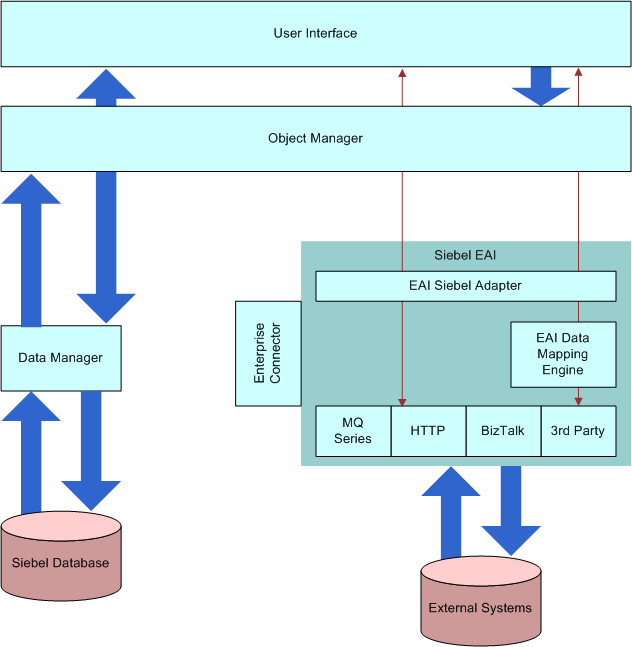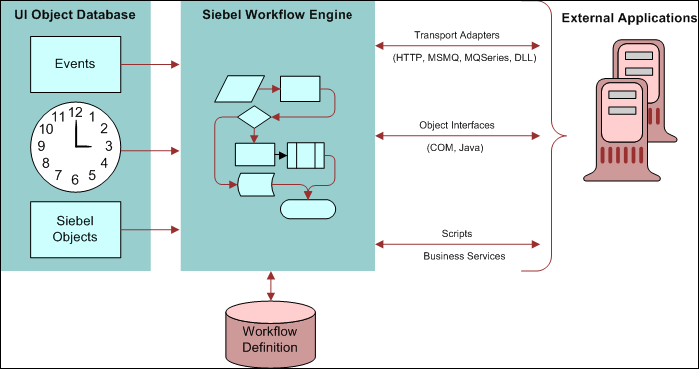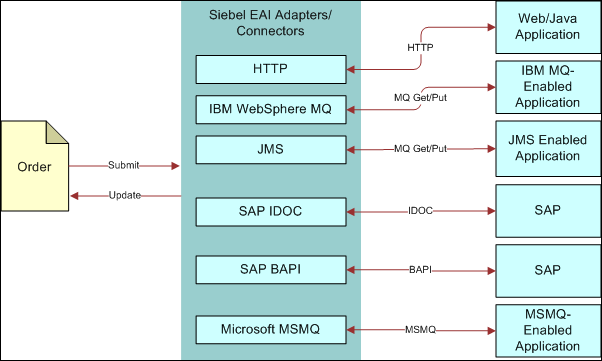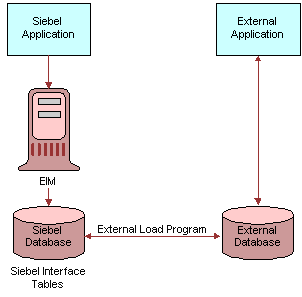4Architecture for Siebel EAI
Architecture for
This chapter describes the architecture. It includes the following topics:
Overview of Architecture for
This topic describes an overview of architecture with . It includes the following topics:
Architecture
The following illustrates the architecture, which includes the EAI Siebel Adapter, the EAI Data Mapping Engine, and multiple transports that can facilitate data integration with different external systems.

Because data management functions are abstracted to the object layer, declarative configuration can be used instead of a procedural configuration, such as scripting. Declarative configuration improves and simplifies configuration work while lowering the costs associated with maintenance.
Integration Requirements for
The following table describes data and application integration requirements and their corresponding features.
Table Integration Requirements and How They Relate to
| Integration Requirement | Feature or Component | Description |
|---|---|---|
Integration requirements include:
|
features and components include:
|
In an integration project, you must supply metadata. Siebel applications provide XML as the common format for representing external application data. Siebel applications provide an object type in Siebel Tools, the Integration Object, and an Integration Object Wizard, which simplifies the work of creating an integration object. |
Integration requirements include:
|
features and components include:
|
allows you to define the type of data to exchange, and allows you to export an XSD or a DTD for a Siebel integration object. |
Integration requirements include:
|
features and components include:
|
For more information, see Business Process Coordination with Siebel Workflow. |
Integration requirements include:
|
features and components include transport adapters, such as:
|
For more information, see Transport Mechanisms. |
Integration requirements include:
|
features and components include:
|
For more information, see High Volume Data Exchange. |
Integration requirements include:
|
features and components include:
|
Not applicable. |
Business Process Coordination with Siebel Workflow
Coordination between multiple business processes requires that the information systems in an enterprise each possess access to the same, up to date information. For example, if a customer address is changed, then the change is reflected in every system that stores the address. The Siebel Workflow Process Designer helps you define the business process flows for your data integration.
The following illustrates how a workflow process can respond to a trigger that is based on an event or to a trigger that is based on time. The workflow calls a transport, a script, or an object interface in order to communicate with an external application.
For more information, see Siebel Business Process Framework: Workflow Guide.

Transport Mechanisms
Many companies standardize on a transport solution, such as MQSeries from IBM, or MSMQ from Microsoft. These transports allow the transportation of messages between systems. Oracle conforms to this standard by allowing you to plug a Siebel application into these environments through the set of adapters, which include the MQSeries adapter, the MSMQ adapter, and the HTTP adapter.
A transport adapter that is developed by Oracle or by a partner that is certified by Oracle, allows diverse applications to communicate with a Siebel application across various operating systems, networks, and databases. The following illustrates the various transports that are available in order to communicate to and from a Siebel application when a new order is processed. One or more of these transports can be used in an integration, depending upon requirements from existing applications and other factors. These transports can also be configured as a Siebel Server Receiver to receive a message. For example, the MQSeries Server Receiver.
For more information, see Transports and Interfaces: Siebel Enterprise Application Integration.

High Volume Data Exchange
In order to avoid a network slowdown or interference with another application, your organization might require a way to schedule a high volume integration at a specific time, typically at night. This type of integration often involves updating hundreds of millions of customer records. This high volume of activity requires a batch mechanism that is capable of processing large amounts of data in a timely fashion. Siebel Enterprise Integration Manager (EIM) allows you to schedule a high volume data exchange between a Siebel application and another application when such an exchange is required, and at the required frequency, such as twice a day, nightly, weekly, and so forth.
About the Enterprise Integration Manager
Siebel Enterprise Integration Manager (EIM) can replicate data between a Siebel application and another system at the database layer. EIM provides high performance to import or export large volumes of data. With EIM, you can import and export data from the Siebel Database to other corporate databases. The following illustrates EIM data processing for batch. EIM includes database profiling that improves performance by supporting index specialization in Relational Database Management Systems (RDBMS).
For more information, see Siebel Enterprise Integration Manager Administration Guide.
